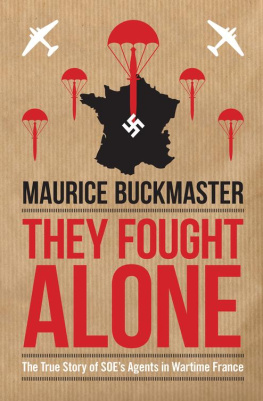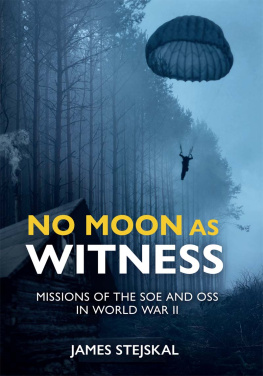RAF AND THE SOE
Special Duty Operations in Europe During WW2
This edition published in 2016 by Frontline Books, an imprint of Pen & Sword Books Ltd, 47 Church Street, Barnsley, S. Yorkshire, S70 2AS,
This book is based on file reference AIR 20/8459, Second Draft, at The National Archives, Kew and licensed under the Open Government Licence v3.0. Appendix XII based on file reference AIR 20/8450 at The National Archives, Kew and licensed under the Open Government Licence v3.0.
Preface Copyright John Grehan
Text alterations and additions Frontline Books
The right of John Grehan to be identified as the author of the preface has been asserted by him in accordance with the Copyright, Designs and Patents Act 1988.
ISBN: 978-1-47389-413-6
eISBN: 978-1-47389-415-0
Mobi ISBN: 978-1-47389-414-3
All rights reserved. No part of this publication may be reproduced, stored in or introduced into a retrieval system, or transmitted, in any form, or by any means (electronic, mechanical, photocopying, recording or otherwise) without the prior written permission of the publisher. Any person who does any unauthorized act in relation to this publication may be liable to criminal prosecution and civil claims for damages.
CIP data records for this title are available from the British Library
For more information on our books, please visit
www.frontline-books.com
email
or write to us at the above address.
Preface
Few people in the summer of 1940 could possibly have envisaged just how extensive and effective an organisation the Special Operations Executive would become by the time of the Normandy landings just four years later. Even today, despite the many studies and memoirs that have been published, the scale of the destruction and disruption achieved by the SOE, and the Resistance movements it co-ordinated, supported and supplied, is rarely understood or appreciated.
This vast network, operating in every region of France, as well as in countries and regions such as Belgium, Holland, Denmark, Norway, Poland, Italy and the Balkans, required enormous logistical support, and possibly the most remarkable aspect of the whole SOE story was how this organisation was maintained in the field. In preparation for the widespread campaign of sabotage planned to inhibit the Germans response to Operation Overlord , 10,000 tons of supplies were dropped secretly into France or transported across the coast, which included weapons for more than 350,000 men, 600 tons of explosives and 800,000 hand grenades.
When the Resistance leaders received word that Overlord had begun in June 1944, they started their campaign of sabotage and disruption all across France. For months prior to D-Day, SOE headquarters at Baker Street in London had studied the French infrastructure and planned an enormous programme that effectively shut down German communications throughout the country. This involved, for example, sabotage against the rail system and electrical facilities (mainly power lines), attacks on German command and control centres, or the destruction of enemy ammunition depots and fuel dumps. The Resistance also obstructed the movement of the German forces that could potentially reinforce the troops defending Normandy by blocking roads and demolishing bridges, while telephone and teleprinter cables, whether above or below ground, were cut.
At the most crucial time of all when the Allies began landing on the flat beaches of Normandy the Germans suddenly found much of their communications cut, their railways and roads blocked and saw their fuel and ammunition storage facilities blown sky high. Had it not been for the activities of the SOE and the Resistance, the Allied troops in Normandy would have had a far more difficult task establishing a foothold in France and even more difficulty breaking out from the beach-heads. Much of this was only made possible by the secret and highly dangerous operations of the RAF.
Any present-day historian endeavouring to relate these activities, or other operations conducted by the SOE, is hindered by the dearth of original material. There are a number of reasons for this. The first is that it was initially a new department under the Minister of Economic Warfare with no existing structure, central registry or departmental filing system, and the very nature of its cloak and dagger operations attracted individuals more interested in action than administration. This lack of, or disregard for, thorough record keeping was further compounded by the rapid growth of the organization. At its peak, the SOE employed some 13,000 agents and staff (10,000 men and 3,000 women), with around a million sub-agents across all theatres and regions around the world.
The second reason, as the historian of the SOE in France, M.R.D. Foot discovered, was because of the dense fog of secrecy in which it lived. Foot found that wisps of [that] fog still keep getting in the way of the seeker of past truth. There were a number of known instances where betrayals by individuals led to mass arrests, torture and murder. Mistakes were also made, even by senior staff, which had similar consequences, and in the dark world in which the agents worked it was not always clear who was the enemy. It was no doubt thought that such things were best forgotten and efforts by historians to dig up the past were not encouraged.
The third, and principal reason, for the existing lack of original documentation is more related to smoke than fog. In 1946 the SOE was closed down. It wound up its operation, as Nigel West put it, with inordinate haste, destroying documents wholesale. As the organisation was being dismantled its files were roughly weeded by staff members who had helped to compile them.
Many of these papers were taken onto the roof of the Baker Street building where they were burnt; on one occasion this was witnessed by personnel at the nearby headquarters of Marks and Spencer. Unfortunately, the fire got out of hand and the fire brigade had to be called. Just how much material was intentionally destroyed and how much accidentally lost is not known, but Norman Mott, the head of the SOE Liquidation Section in Baker Street, claimed: The entire contents of my office where I was holding a considerable number of operational files In addition, all the handing-over briefs from the SOE Country Sections were destroyed as well as a good deal of material relating to investigations into blown rsaux [circuits]. What remains of the SOE material is estimated to amount to no more than fifteen per cent of the original total.


















